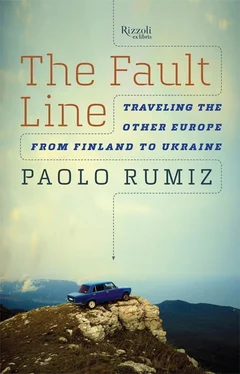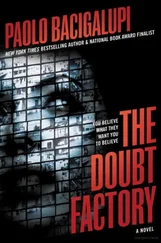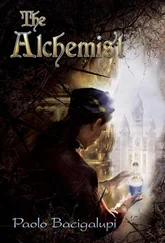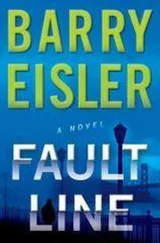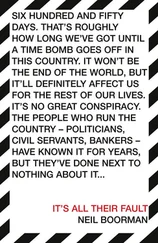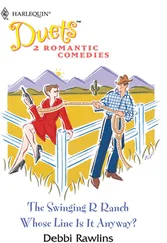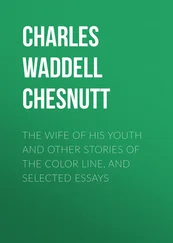It’s not easy to explain this complicated place, and Regina has to help herself with a drawing. She tears out a page from my notebook and draws a Baltic space that is totally new, where the nation-states are absent but historical regions crop up on all sides. Jutland, Livonia, Latgale, and then, in Polish, lands whose untranslatable names sound more or less like Kizensky, Zenigalsky, Rizensky, Vizensky. They are the territories of the “Deluge,” swept away by the Polish-Swedish War, a disaster that destroyed Poland like a “plague of locusts” between 1600 and 1629. The drawing is thick with annotations and important dates: 1553, 1583, 1722, 1795, arrows indicating the movements of the armies, lines representing roads but more often borders, occupations, liberations. Looking at this brown-haired woman bending over her map, I realize that Latvia is the center of my journey. That paper is a cornerstone, the frame of the squeaking front door to old Europe. A Sarajevo of the North.
Ludza—yet again the shadow of the frontier. Clouds swirling above lakes and forests, over the maternal dome of the Orthodox church and the spire of the Catholic one, like a meringue. Once the country’s population was 50 percent Jewish, and it is said that in 1906, when a pogrom was ordered from outside, the local Christian population rebelled and proudly saved their Jews. Today the people of the synagogue have vanished, and Russians have taken their place.
Forgotten by the central government in Riga, they are the new “strangers.” We arrive in town on the day of the Latvian national holiday, on which it is obligatory to display the flag. A scowling Russian is in the process of lowering his flag at twilight and says, “I have to show the flag; if not, they hit you with a fine.” Like everyone who is part of the ex-Soviet minority, he too is under special surveillance. We have a lot of good reasons to explore the lake.
Already at seven thirty the streets are deserted. The only open store is the alcohol-and-sweets shop across the street from the Orthodox church. It’s a curfew that cannot be explained simply by the lake being so near to Russia. This is the void left by a heavy absence, and it is surely the absence of the Jews. Monika strikes up a conversation with Anna Sergeyevna, who is looking out the window of her ground-floor apartment together with her granddaughter Viktoria and a six-month-old dog. There’s only one Jew left, she says. His name is Bernacki and he is a lovely person. He lives two blocks from her house, on the way to the country. “The others have all gone. They come back every now and again just to visit their dead in the cemetery.” But for a lot of the dead Jews, as we know, there is not even a tomb; after the Holocaust, all that’s left of them is a name on a plaque. But when did the last Jews leave? In the early 1990s, as soon as the Communist regime fell and it was easier to get a visa. And the synagogue? Where was the synagogue? Anna Sergeyevna points the way. It’s about three hundred yards toward the lake. It was right under our noses and we hadn’t even noticed.
The void—that’s the sensation of the curfew in Ludza. A recent void, unfilled and perhaps unfillable. The Jews did not disappear in the Hitler years, as we had thought, but fifty years later. The break is recent, perhaps irreparable, in this all-Russian ghetto where Latvians would rather not live. But there’s the synagogue.
In the style of the 1700s, in dark wood, with a roof that looks like the upside-down hull of a galleon, alone on the edge of the lake populated by ducks. Before we left on our journey, Monika had showed me a book on wooden Jewish houses of worship in Eastern Europe ( The Doors of Heaven ) and now I am looking at one of those forgotten masterpieces here in Ludza, where Mount Zion seems to have wedded the forests of the North. Through the basement windows, we can see that the books are still there. Nothing but the wind has touched them. Abandonment, not devastation. Until 1991, we are told by people in the neighboring houses, you could still see the lights shining on the first floor.
The ground floor is bolted shut, but we’re able to get inside through the women’s gallery by way of a shaky external stair. From up top, you can see everything: the ark, the side benches under the large windows, the octagonal elevated platform for the reading of the Torah, the ceiling like the keel of a ship, on which something may have been painted. Under the gallery, a collection of closets, old books still open, ornaments that shine in the half-light of the evening.
It’s striking to feel like an archaeologist of an era that ended less than thirty years ago. We go out to look at the lake in the twilight. Water the color of bronze, the sky almost green, two semicapsized boats, a small monument to the Jews exterminated by the Nazis. The splash of a jumping fish that breaks the silence. Amid the many flourishing trees, there is only one that’s black and dried up. On one of its branches, two crows as black as the tree seem to be listening and eager to tell us something. Then we are swallowed by the night, the first really dark night of our journey. We go to bed without saying another word.
The next day we go back there. Monika has a sense that there’s something more. There’s a house that has an air of mystery about it. It looks like a puzzle, as though in just a few years not one but five or six eras had superimposed themselves in it, inside and outside of the perimeter walls. In the garden there is an old woman hoeing. She too is clearly Russian, and her name is Rita. “Yes, the Jews used to pray here, too,” she says with a wide smile, and she explains that the synagogue was transformed into a barn by some beastly men in uniform. Those animals declared the people that prayed there “aliens,” killed them, and buried them in the woods. One day, however, the barn again hosted pious men and became a place of celebration, music, and joy. But since in the lives of mankind, the dark times and the joyous times inevitably alternate, one day the house again became a place of sadness, the last refuge of people labeled “aliens” by a heartless Europe.
This is the story of Rita and Volodya, old Russians trapped in Latvia by the latest shift of the moving frontiers, an unimaginable story of forgotten Europeans, third-class passengers, hidden like something to be ashamed of in the last cars of the luxurious train of the “community.”
“This was a synagogue,” Rita explains, “but in 1941, Hitler kept his soldiers’ horses here. You know what happened next. Thousands of Jews murdered, even here on the lake. Then we came, in 1946. Come on in, dear friends. I’ll show you what it’s like on the inside.” She goes in the house, lifts up a carpet, opens a trapdoor and shows us a cement drainage hole. “The Nazis built this to drain off into the lake the water they used to wash their horses.”
Inside the walls are wood slats; the arcades have been shortened and turned into windows.
“In the beginning, a lot of Jews came back. God only knows from where. Auntie Gyela, Auntie Fruma… dear people, we called them aunt and uncle. And then Boris Gansen, Jasko Moissev, Doctor Schmutze, old lady Zagoria. Today there’s hardly anybody. They either died or went to Israel.”
I ask where she was born and her surname.
She pulls out her passport, shows me something printed in Latvian: Nepsilona Pase . Just underneath, the English translation: Alien’s Passport. An alien, a nonperson, someone who can’t vote even in local elections.
“What do you want? I’m not Latvian enough, I’m no longer Russian, and my first identity card was Soviet. There are a thousand of us here in town. We’re supposed to pass a language exam and a national loyalty test, but what can you do? I’m too old to learn Latvian. You know, in the beginning I felt really bad, but today I don’t even think about it.”
Читать дальше
